Malcolm Daniel Edward Macarthur looked as if he’d swanned straight out of an Agatha Christie novel. With his bow ties, cravats, silk handkerchiefs and cultured accent, he seemed a gentleman right down to his manicured fingernails. The comparisons with a Christie whodunnit ended there. There were no neat murders, no whiff of strychnine, or any sporting denouements. Instead there was violence that was brutal, frenzied and gruesome.
Macarthur’s crimes during the sweltering summer of 1982 sparked what was then the biggest murder hunt in the history of the Irish State. By a series of extraordinary coincidences the case would worm its way to the core of the government, lead to the resignation of the attorney general and almost topple the shaky administration of then taoiseach Charles J Haughey. Forty years later the effects of this extraordinary sequence of events are still rippling outwards.
Perhaps the only phrase that fully captures the events of that summer is the one inspired by Haughey’s comments at the time: “Grotesque, unbelievable, bizarre and unprecedented.” Or, shortened to its infamous acronym, Gubu.
“Absolutely sensational. I mean, it was probably one of the most sensational stories that I can think of, certainly in my career and at any stage in the last 50 years,” says Peter Murtagh, who was then security correspondent of The Irish Times. “In the age of social media, Twitter would just implode. Facebook would melt down. It’s that sort of situation.”
‘Is this for real?’ Bridie Gargan said. Then she began to panic. Macarthur reacted explosively. Taking a lump hammer out of his bag, he began to hit her repeatedly on the side of the head
It began on Thursday, July 22nd, 1982. The day followed the pattern of the previous three weeks: high heat, brilliant sunshine. Dublin city centre was like a furnace that afternoon, the air shimmering in the streets.
Many people were wearing T-shirts, but the man who got off a bus on Eden Quay, near Heuston Station, cut an incongruous figure. He was wearing clothes more suited to winter: a heavy tweed jacket, a cravat, a tweed fisherman’s cap pulled over his forehead. He sported a neatly trimmed beard and needed to look over the rims of his thick reading glasses to see.
He carried a blue holdall in one hand and a long object tightly wrapped in polythene in the other.
A gallery of contemporaneous reporting
If you have any issues with viewing these reports please click here to view them in full.
0 of 23
He walked towards the Phoenix Park. Thousands of people were in the park that day, enjoying the weather. He followed a grassy jogger’s path that runs parallel to Chesterfield Avenue. Malcolm Macarthur was, he later admitted, searching for “easy prey”.
Others had noticed this odd man with his odd behaviour. A woman with her children had seen him crawl though long grass towards her car. He moved off after she alerted her husband, who was sitting nearby.
Half an hour later he arrived outside Deerfield, the US ambassador’s residence in the middle of the park. A young woman had parked her car near Deerfield’s back wall, close to the jogger’s path. Her name was Bridie Gargan. One of a family of 11 children from Dunshaughlin, Co Meath, she was a nurse at St James’s Hospital, across the River Liffey. Bridie was universally popular, with a personality as sunny as that summer’s day. After finishing her shift she had parked her Renault 5 near the jogger’s path, to sunbathe for a while before going to her flat in Castleknock, just outside the park.
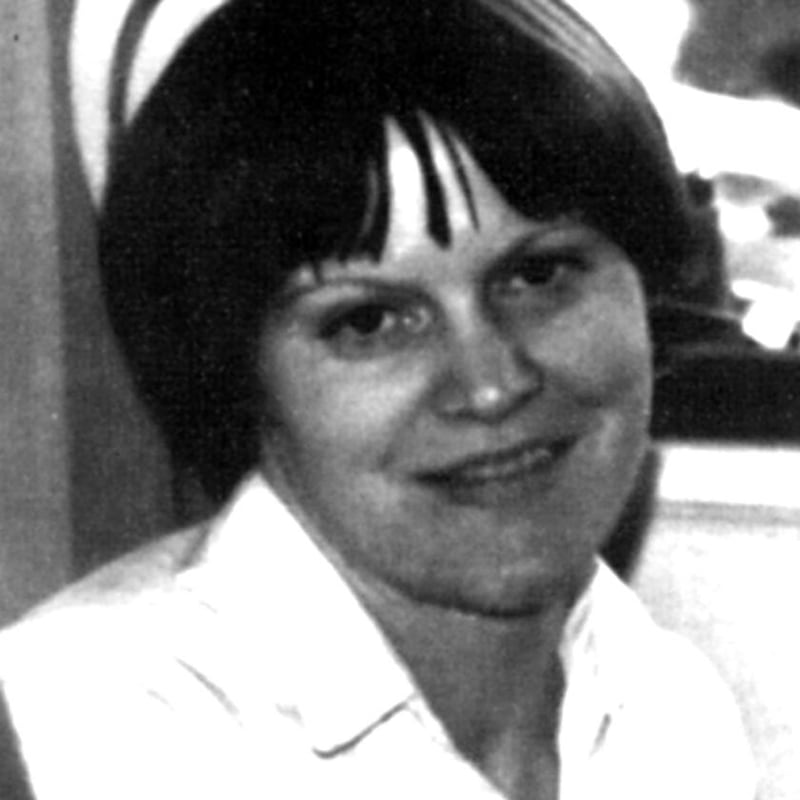
Macarthur approached her and produced what looked like a gun from the bag. It was in fact a crossbow that he had refashioned and painted black. He ordered her into the car. She was calm at first as she dressed. “Is this for real?” she said. But once she was bundled into the back seat of the car she began to panic. Macarthur reacted explosively. Taking a lump hammer out of the bag, he began to hit her repeatedly on the side of the head.
Only one other person noticed what was happening. Paddy Byrne was a gardener at the ambassador’s residence. He had already noticed the man behaving oddly, skulking behind trees. Byrne is now 84. We stand at the spot in the park where the attack occurred and he describes what happened. Even today he recalls the incident as vividly as if it happened yesterday. He ran over and was out of breath by the time he arrived at the scene.
“I went to the car and I said, ‘What the f**k is going on here?’ Jesus, there he was, sitting sideways on the seat. She had a paper around her, and you could not see her. She heard my voice and tried to get up.”
He saw the extensive blood on her face and blouse and knew she was badly injured. Macarthur jumped out of the car and pointed the “gun” at him. “If you don’t get the f**k back I will put a bullet through your head,” he shouted at Byrne.
In that unreal moment, despite the thousands of people in the park, the world had been reduced to just three people: a murderer, a victim and the sole witness. As Macarthur advanced, pointing the refashioned crossbow at him, Byrne stumbled back and fell into a drain behind him.
An ambulance driver who pulled up alongside the nurse’s car spotted the St James’s Hospital sticker on its window. He also saw the blood, the respectable-looking driver and the badly injured woman in the back. So he gave the car a blue-light escort through the traffic
Macarthur sped off in the car along the jogger’s path — with a young woman, bloodied and dying, in the back seat. Byrne frantically tried to flag down passing cars. A park employee saw him. They contacted the Garda and drove around the park, looking for the car, but could not find it.
Macarthur made for the Islandbridge exit. It was now after 5pm, and there was a line of cars at the gate. By coincidence a Waverley ambulance pulled up alongside, and its driver spotted the St James’s Hospital sticker on the front window of Bridie Gargan’s car. He also saw the blood, the respectable-looking driver and the badly injured woman in the back. So he gave the car a blue-light escort through the evening traffic to the hospital.
An interactive map of the key locations
But once inside the grounds of St James’s, the ambulance driver saw that the car had done a U-turn and sped off. An hour later it was found abandoned off South Circular Road, in Rialto. The young nurse lay unconscious on the back seat. She was still alive but in a critical condition. She clung to life for four days, dying the following Monday.
A vital piece of evidence had been left behind in the Phoenix Park: the long object wrapped in polythene. When it was unwrapped, gardaí discovered it was a shovel. There were fingerprints on the polythene, but they matched no known assailant’s.
Tony Hickey and John O’Mahony both became assistant commissioners in the Garda Síochána. Back in 1982 Hickey was a detective sergeant with the murder squad, O’Mahony a rookie detective who was called into what became a complex investigation involving 50 detectives.
Initially, gardaí thought, because of the attack’s frenzied nature, it was the “work of a madman”, as one senior garda put it at the time. O’Mahony was one of those who checked with local psychiatric hospitals, to no avail.
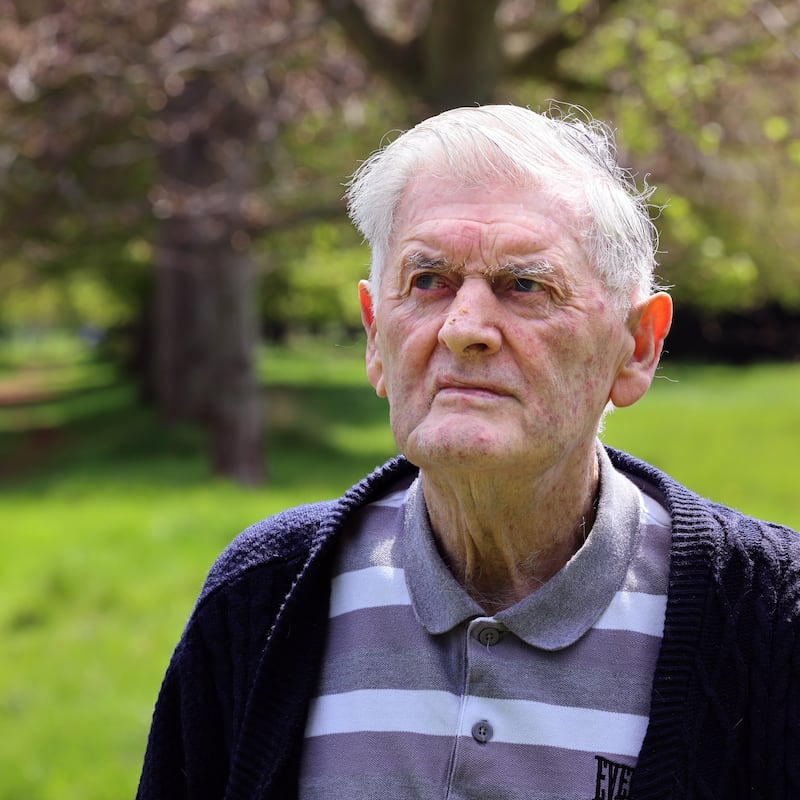
For a few days they had no reports of where the suspect had gone after abandoning the car. Hickey began looking through witness statements to see if there were any common threads. The following Monday morning, on foot of a telephone call, he visited a travel agency on South Circular Road. The woman there said a strange man had come in the previous Thursday and inquired about a Magic Bus tour—a now defunct mystery tour. “She was able to give a very good description of this guy that came in,” Hickey says. “He was sweating—not unusual because of the weather. He told her he’d been jogging the Phoenix Park and that he forgot to bring his salt tablets, and he drank a few glasses of water.
“She got the impression that this guy was somebody that was used to having servants. He ordered her to do things. He said, ‘Get me a taxi. I need to go to Dún Laoghaire.’ And then he was very ill at ease to say the least, and a bit hyper.” The woman told the man that buses to Dún Laoghaire passed the door. He ran out and jumped on the next one to come by—but it was going in the wrong direction, to the north of the city.
Hickey and his colleagues spent a few days establishing the suspect’s movements after he attacked the nurse on Thursday. The bus took Macarthur to Finglas. He bought disposable razors from a chemist’s shop and then went to the Fingal House pub, where he hacked off his beard. It was a working-class pub, and he stuck out like a sore thumb. He bought a bottle of water at the bar and then ordered a taxi, which took him as far as Blackrock, just short of Dún Laoghaire, in south Dublin. After that the trail ran cold.
Macarthur seemed to have lived a gilded existence. He had never worked. He dressed raffishly. There was a widespread assumption he held degrees from Trinity College Dublin and Cambridge University. He did little to dispel this and other myths
Gardaí were flummoxed by the murder. It seemed to be completely random, and the frenzied nature of the violence was unspeakable. The fact that the attacker had carried a shovel also unnerved gardaí. “That rang alarm bells early on,” says Hickey. “This guy, if he’s going to kill people for whatever reason, he’s going to bury them.”
The killer seemed to come from well outside the sphere of the usual suspect. He was well dressed—albeit overdressed—was tanned, had a neat beard and spoke with a “cultured accent”. He also had a lord-of-the-manor way about him, to use Hickey’s phrase.
So who was Malcolm Macarthur?
Sometime around the middle of June 1982 Macarthur came to the numbing realisation that the last dregs of a once-substantial inheritance had drained away. “It all goes back to money,” he would later say. “For the past two years my finances have been diminishing. This was something that I could not cope with.”
To people who knew him, Macarthur seemed to have lived a gilded existence. He had never worked. He dressed in a raffish way that was anachronistic in the 1980s, a decade of synthetics and loud colours. There was a widespread assumption he held postgraduate degrees from both Trinity College Dublin and Cambridge University. He did little to dispel this and other myths, such as that he was immensely wealthy. He did come from some wealth, but his background was more modest than some of his acquaintances assumed.
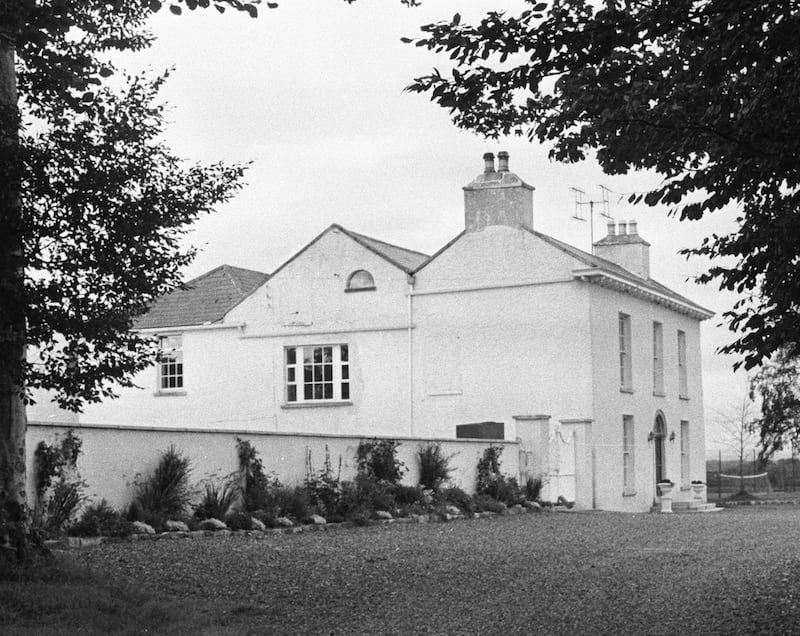
His grandparents were Scottish; they moved to Co Meath in 1906 and bought a Breemount, a substantial house and farm. They were well off — what was slightly unusual about the Macarthurs was that they were Roman Catholic, not Church of Ireland, the religion associated with most large landowners at the time. Malcolm Macarthur’s father, Daniel, was the fifth child, but inherited the house and land. Daniel married Irene Murray, who came from another well-to-do family, in 1943. Malcolm, an only child, was born in 1946.
From all accounts, the Macarthurs’ marriage was not a happy one, with loud and violent rows, and they separated in 1962. They seem to have ignored their child. One anecdote recounts Malcolm leaving Breemount to walk to school while his parents were having a huge row. As he walked down the curved driveway his mother sped past him in her car. Moments later his father did the same. Neither had bothered to stop for their son.
In a 1983 interview with the RTÉ journalist David Hanly, Irene Macarthur said: “I carried on in the tradition that I had been brought up in, and that is the children are seen and not heard. And I went and did my gardening and my horses and whatever else was on, and this girl came in and taught him.” She also said her son was shy and a dreamer and tended to fabricate stories, like his father had.
The late Homan Potterton, director of the National Gallery of Ireland, recalled meeting Macarthur as a child in Breemount. “There was a small boy of our own age there with whom we could play about the farmyard. He was called Malcolm and was an only child; he was also a lonely one. His parents’ marriage was not a happy one — in fact it was a disaster … I never knew Malcolm as an adult, but I have happy memories of playing with him as a child in the sunny farmyard at Breemount. In light of what happened later, it is obvious that demons lurked there.”
After reading about armed robberies carried out by the IRA, Macarthur set about organising a ‘heartless, cold-blooded operation’ to obtain funds. He was quite prepared to kill anybody who got in the way
Macarthur attended the local CBS school in Trim, where he did his Leaving Certificate in 1963. His contemporaries remember an ordinary enough boy who liked science rather than sport; he was no different from the other boys, even in terms of his accent.
A particularly striking photograph from 1959 shows the under-14 Summerhill football team. On the far left of the photograph we see a boy standing clearly apart from, and a few paces behind, his team-mates, who are arranged in two rows. He is a handsome boy with bristle-thick hair. It is Malcolm Macarthur. He is wearing a jacket over his jersey. It strongly reinforces the image of his being an outsider.
One of his uncles, Jack, was a judge in California. At 17, Macarthur moved there to do a degree. Four years later he graduated from the University of California at Davis, with a degree in economics and history. The flower-power movement was in full swing in Haight-Ashbury in nearby San Francisco. He ignored it, presenting himself instead as a young fogey. On his return to Ireland in 1967 he registered to do a master’s degree at Trinity College Dublin but never completed it. He rarely, if ever, worked. After his father’s death, in 1971, Macarthur came into a substantial inheritance. When Breemount was sold he got more than half the proceeds, as much as £100,000.
He set himself up as a man of learning and leisure, showing off his wide-ranging knowledge. Some found his personality impenetrable. He was variously described as a loner, as shy, as an outsider, as an eccentric. In the early 1970s he began hanging around fashionable bars in Dublin, such as the Bailey and Bartley Dunne, which were known for their eclectic clientele. It was there he met his partner, Brenda Little. One of her closest friends was a barrister, Patrick Connolly, who shared an interest with her in film and opera. It was through her that Macarthur met Connolly, who among other things had represented Charles Haughey at the infamous Arms Trial of 1970.
Connolly and Haughey had maintained a friendship throughout the 1970s. And now, through Brenda Little, he became an acquaintance of Macarthur. Both friendships continued on what were parallel tracks until they spectacularly collided in 1982.
Macarthur and Little had a child in 1975; they lived between London and Dublin. They were caretakers in Connolly’s old flat in Donnybrook for a while in early 1982. In May that year they made another life-changing decision: to move to the island of Tenerife, almost 3,000km away. What Macarthur did not tell Little was that by now he was broke—and could not cope with that reality. On Tenerife, after reading about a number of armed robberies carried out by the IRA, he began to work on a scheme where he could “stick somebody up” and continue his dissolute lifestyle. He set about organising a “heartless, cold-blooded operation” to obtain funds. He was quite prepared to kill anybody who got in the way.
Macarthur’s mother described him as a fantasist and dreamer. He started walking into hotel lobbies carrying a brick, to ‘test himself’ as a criminal. His strategies to kill in order to acquire a car and gun were delusional given that he could have easily acquired them on the streets
His mother had described him as a fantasist and dreamer. Certainly there was a disconnect in his relationship with reality. He started walking into hotel lobbies carrying a brick, to “test himself” as a criminal. His strategies to kill in order to acquire a car and gun were delusional given that he could have easily acquired them on the streets.
A lawyer familiar with the case to whom I spoke many years later said that Macarthur adopted a subjective Nietzschean view of himself, as a man who became Übermensch, or superman. “He placed himself above the moral and societal orders, and concluded in his own mind that acts which he had committed could be undone simply by wishing them away.”
Murder was an infrequent crime in Ireland back then. In 1981 a total of 24 murders had been recorded in the State. But between July 22nd and 26th the following year, there were four. In addition to Bridie Gargan’s, another young woman, Patricia Furlong, was murdered at a music festival in Rathfarnham; a postmaster, Robert Belton, was shot dead by the IRA during an armed raid; and a young farmer was murdered in Co Offaly.
The murder of the farmer, Dónal Dunne, resonated with Hickey and O’Mahony, the detectives working on the Gargan case. Dunne was a 27-year-old who lived just outside Edenderry, about 60km west of Dublin. A clay-pigeon-shooting enthusiast, he had advertised a shotgun, a Japanese Miroku, for sale in the Evening Press newspaper. A man had contacted him to say he was interested in buying the gun. The man arrived on Saturday, July 24th, after getting a bus from Dublin. It was two days after Bridie Gargan had been attacked. The man was Malcolm Macarthur.
He moped around the town. He spent the night on a park bench close to the town’s harbour. The following morning he bought a carton of milk and a Sunday newspaper and read it while sitting beside the Grand Canal. He telephoned Dunne and asked him to collect him.
They went out to the grounds of the clay-pigeon club, on bogland a few kilometres outside the town. Later, Macarthur would give his version of what had occurred. “We got out of the car and Mr Dunne took the gun from the boot. It was in a case. He told me that he didn’t really have to sell the gun but that if he got what he paid for it that he would sell it. He told me it cost him £1,100 but that he would not sell it at a loss. I wanted a gun badly, but I did not want to buy it or I could not buy it.
“Mr Dunne put two cartridges into the gun, and I shot at a target which was a white post. I was trying to think of a way of getting this gun without paying for it, and I was playing for time. Mr Dunne then got a bit angry and reached out and put his hand on some part of the gun to take it. I pulled back and pulled the trigger and shot him in the head. He fell down. I ran towards Mr Dunne’s silver car.”
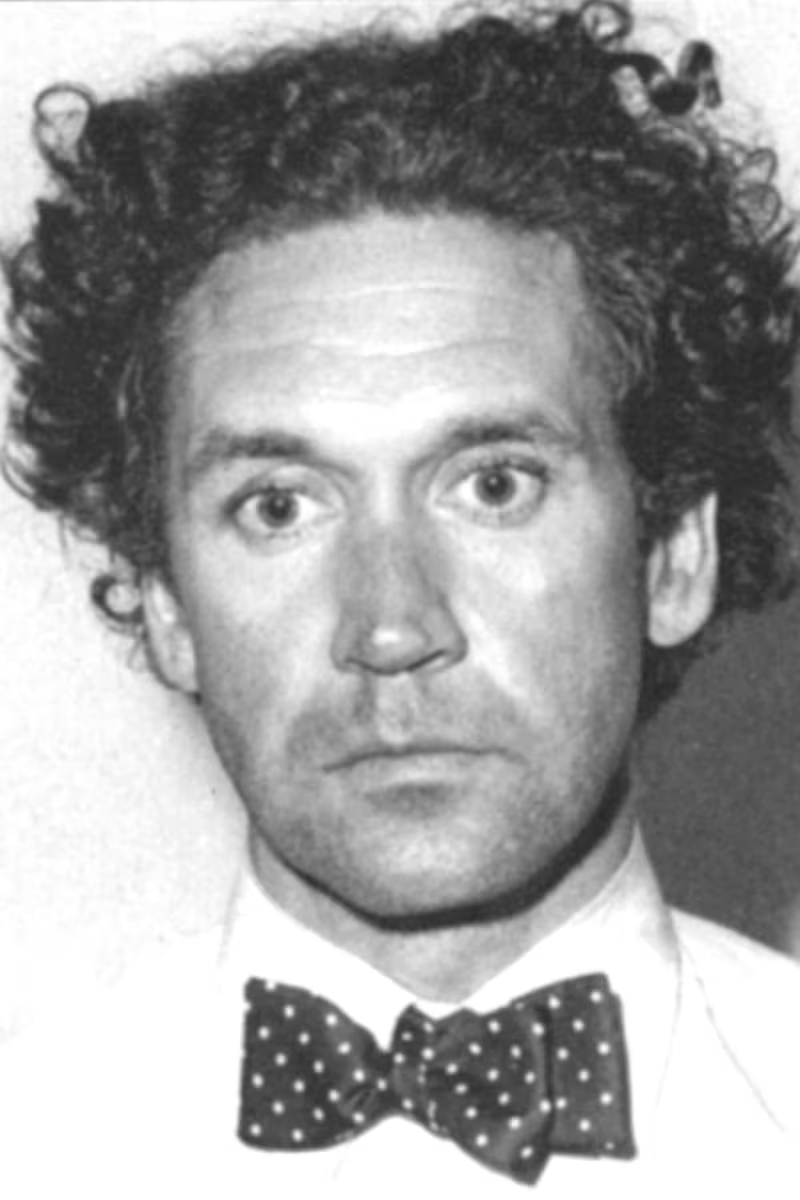
It was shocking. A young man with a happy-go-lucky and faultless disposition had been summarily executed. The killer made a half-hearted attempt to hide the body. He stole Dunne’s Ford Escort and drove it back to Dublin. As it happened, the Leinster senior hurling final was on that day, and Offaly was involved. Legions of supporters were driving to Dublin. As they approached the capital a group of supporters in another car were unsure how to get to Croke Park. They spotted the silver Ford Escort with the Offaly registration ahead of them and followed it into the city, assuming it was travelling towards the stadium.
The car went instead to Temple Bar, in the city centre, where they saw the driver get out. The supporters said that he was a clean-shaven man with wavy brown hair and that he was wearing a tweed jacket despite the searing temperature. He took a holdall from the car.
Later that day a Dublin family were picnicking in a field near Edenderry. One of the children came across a body lying half-hidden in the long grass. It was Dónal Dunne.
It would be some time before the two killings were formally linked, but within days the Gargan murder team, headed by Supt John Courtney, strongly suspected a link. Courtney, a phlegmatic Kerryman, was a controversial policeman who critics said allowed the use of heavy-handed tactics. But he was also a thorough investigator, and this was probably his best case.
Macarthur quickly made himself at home in Connolly’s flat. He ordered Perrier water plus copies of The Irish Times and Private Eye, all delivered by taxi on the attorney general’s account
Witnesses in Edenderry came forward to talk of the stranger’s tweed clothing, his glasses, his wavy hair and his “bohemian style”. His cut-glass accent was also noticed. Gardaí found a copy of the Sunday Independent newspaper that he had discarded near the canal and were able to lift fingerprints off it. They matched them to those left on the plastic that covered the shovel in the Phoenix Park.
Much of the initial Garda investigation focused on north Dublin—Macarthur had got the bus to Finglas. There were also sightings of him earlier in July at clay-pigeon shooting grounds in Balheary, in north Dublin, and in Ashbourne, Co Meath. He had hung around in unsuccessful attempts to steal a gun. But since July 8th, a fortnight before the attack on Gargan, he had been on the other side of the city.
Macarthur had told Brenda Little he was going from Tenerife to Switzerland to sort out his finances. Instead he returned to Ireland on July 8th and booked a room in a guest house in Dún Laoghaire. He had chosen it as it would be easier for him to go incognito. Over the next 10 days he grew a beard, wore tweeds and wore glasses that he clearly did not need. His ludicrous appearance during a heatwave made him stick out.
After he had brutally killed two people within days of each other, he returned to Dún Laoghaire and laid low. He rang Little in Tenerife and told her he was in Ostend, in Belgium, and would return to Tenerife within a week. He was now running desperately low on money.
His attempts to “stick somebody up” turned into fiascos. He arrived at the home of a casual acquaintance on Fitzwilliam Square, in central Dublin. He was wearing rubber gloves that he said he needed as he had dermatitis. He also carried the blue holdall, which probably contained a shotgun. But the elderly owner of the house was not alone. His son and daughter-in-law had joined him, and they invited Macarthur to stay for dinner. He removed the gloves and talked knowledgeably about the preservation of Georgian buildings in the area. He did not leave the house until 1.30am.
A few days later, on August 4th, a retired American diplomat, Harry Bieling, answered his door to be greeted by a stranger. He lived in an eye-catching castellated house called Camelot, at the top of Vico Road in Dalkey, in south Dublin. The stranger told Bieling he had attended a party at the house eight years previously, but Bieling could not remember the man.
There is an extensive account of this incident in The Boss, a book about Charles Haughey’s time in government. Peter Murtagh, who wrote the book with Joe Joyce, says Macarthur told Bieling that he wanted to take a photograph. “Bieling notes that it’s very misty, so you’re not going to get a good photograph today. And Macarthur, I believe, said, ‘Well, this is exactly as I remember it,’ you know, so they wander around the house with Macarthur making sure, in retrospect, that nobody else was there.”
Macarthur began rummaging in his blue holdall, telling Bieling: “I hope you have a sense of humour.” Then he produced a gun and demanded money. Murtagh takes up the story: “They go through this sort of bizarre minuet, almost a gentlemanly minuet, sitting down together, and Macarthur has the shotgun across his lap, pointing it at poor Mr Bieling, and they chat about this, that, the other.”
Macarthur demanded £1,000. Bieling said he did not have that kind of cash. Astonishingly, Macarthur told him to make out a cheque for that amount. Bieling said he kept his chequebook in his bedroom. The two men went to the top of the spiral staircase. The drawer was empty. Bieling then told Macarthur it must be in the livingroom. Halfway down the stairs Bieling bolted for the door and escaped into the garden. Macarthur had a cursory search and then flagged down a van on the street. He told the driver to take him to Pilot View, an upmarket apartment development in Dalkey. But when he got out of the van he walked in the opposite direction.
Around the same time a young man walked into the Garda station in Dún Laoghaire. John Monks sold newspapers on a stand in the town and on the seafront. The previous night a reconstruction of the Bridie Gargan murder was shown on Garda Patrol on RTÉ. Monks thought the suspect looked very like one of his customers.
A rookie detective at the station named John O’Mahony was assigned to take a statement. There was a detail in the statement that John Courtney noticed. Monks described a beige military-style jumper that the man had worn, with patches on the shoulders and elbows. It was similar to the one discarded by Bridie Gargan’s killer. Gardaí had not released information about the jumper.
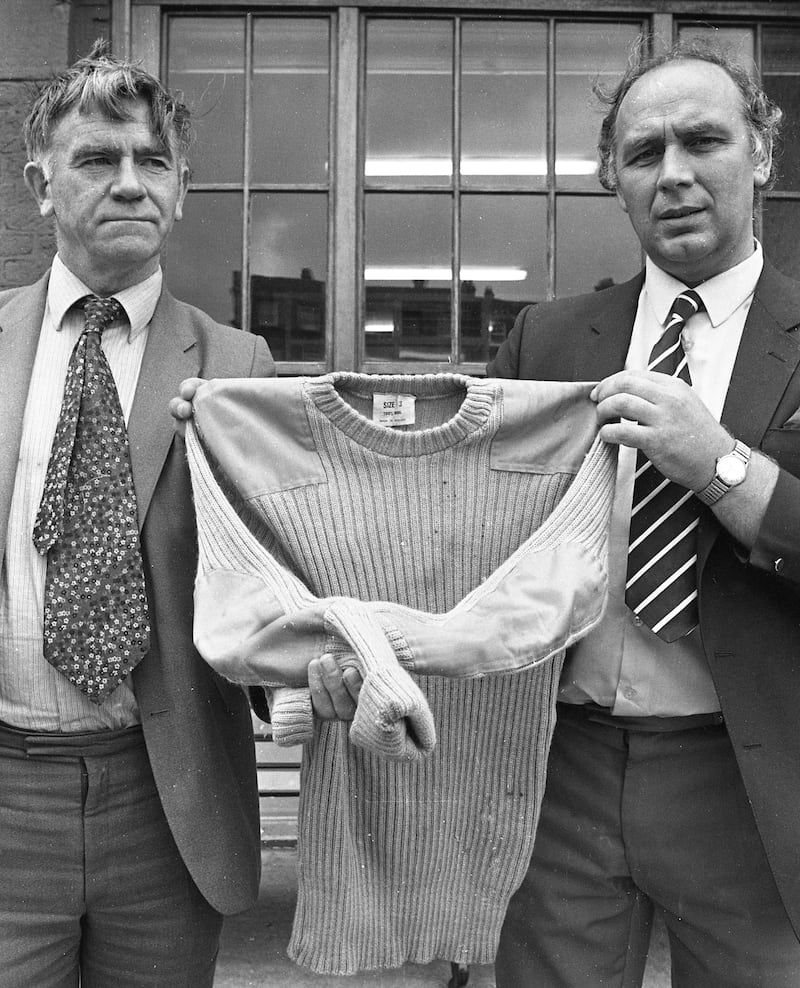
Monks also described Macarthur arriving at his stand a few days previously. No longer wearing a beard, he arrived on a red racing bike to conduct what Monks called an unofficial identity parade. “He just walked up to me and stood only a few feet away. At first I thought he was going to buy a newspaper. Then I realised he seemed to be checking to see if I recognised him again.”
O’Mahony says the important thing was that Monks had seen Macarthur with the beard and when he had shaved it off. He and another detective trawled the streets with Monks in the hope of spotting Macarthur, but Monks never saw him again.
Of course, Macarthur had moved by this stage. On the night of the aborted robbery attempt on Harry Bieling he arrived at the Pilot View apartment owned by Patrick Connolly. By now Connolly had been appointed attorney general in Charles Haughey’s rocky government, which had been formed five months earlier, in February 1982.
Brenda Little had phoned Connolly to say she was worried about Macarthur, as he had not contacted her for several days. He got Macarthur to phone her. Connolly was put on the phone. Little asked him to put Macarthur up for several days as he was too shy to ask. He agreed. Macarthur told Connolly he had been in Switzerland dealing with his finances.
I interviewed Connolly 10 years later. He told me he had no reason to disbelieve what he had been told. “Malcolm Macarthur was not the kind of person of whom you would ask what he had been up to. Perhaps I should have noticed. I am not at all observant. If I had really looked I would have noticed, for example, that his shoes were very run-down.”
Macarthur quickly made himself at home. He ordered Perrier water plus copies of The Irish Times and the English satirical magazine Private Eye, all delivered by taxi on Connolly’s account. It was from Connolly’s flat the following day, Thursday, that Macarthur made an extraordinary phone call. He rang Harry Bieling. When Bieling answered he could hear Beethoven’s Seventh Symphony being played in the background.
“Hello, this is your friend from yesterday,” said Macarthur. “Why did you run?”
There was a pause.
“Oh, you must have been scared,” said Macarthur. “Silly joke gone sour.”
He then suggested that one of them should contact the Garda.
“You do it,” Bieling told him.
Macarthur even said he might call around the following week. “Yes,” said Bieling, “but telephone first.”
Bieling, of course, had already contacted the Garda the previous night. But that day Macarthur rang Dalkey Garda station.
He told Sgt Pat Fitzgerald it was a practical joke that had gone sour. Fitzgerald asked for his name. He responded “Malcolm Macarthur” and gave his address as being on Gardiner Street, just north of the River Liffey in the middle of Dublin. Sharing his name as carelessly as that was a monumental blunder—and showed how detached from reality he was.
The Bieling incident prompted Det Supt Michael Sullivan in Dún Laoghaire to call John Courtney, the head of the murder squad, and declare, “I think I have your man out here.”
A few days later, on Sunday, August 8th, there was another surreal moment. Patrick Connolly, a lifelong GAA supporter, regularly went to games with his brother Tony. The All-Ireland hurling semi-final was on that Sunday between Kilkenny and Galway. The brothers travelled in the State car across town to Croke Park. With them in the car was Tony’s son — and Paddy’s nephew — Stephen, as well as Macarthur.

The Connolly brothers watched the game from the Ard Chomhairle section; Macarthur and Stephen got tickets for the Hogan Stand. Macarthur wore sunglasses and seemed ill at ease. Stephen also noticed that he had grass stains on his trousers and that his white shirt was dirty. One account put Connolly and the Garda commissioner discussing the case with Macarthur in their presence. That was a myth, however, one of many in this case.
By this stage, the investigation, involving 50 detectives, was focused on Dalkey. In his initial interview with gardaí Harry Bieling had shared some of the names of mutual acquaintances that his would-be robber had mentioned. He said a woman named Betty Broughan, who had been at all his parties, might know who this man was. When Hickey and a colleague contacted her and described the suspect, she immediately recognised the man as Macarthur. That was the bombshell. Hickey could feel the hairs rising on the back of his neck.
Now they had to find out where Macarthur was. Broughan knew a man who kept the contact details of a wide circle of people in that social group. Gardaí got in touch with him and he told them that Macarthur had moved to Tenerife but that he, his partner and a child had been living in a flat in Donnybrook earlier that year. Gardaí visited the flat and found out that the person who had held the lease on the flat was Patrick Connolly. He now lived in Pilot View in Dalkey.
So now gardaí had two references to Macarthur and had traced his movements to two places, both connected to Patrick Connolly. Hickey and a colleague, Denis Donegan, had done door-to-door inquiries in Pilot View the day before and knew Connolly lived there. They now had Macarthur staying in a flat owned by Connolly in Donnybrook and going to a small development where he lived.
The investigation was gathering momentum. Hickey and a colleague went to Pilot View on the afternoon of Friday, August 13th. They saw a man at the window of Connolly’s apartment who looked very like the suspect they were seeking. A taxi pulled up. When they stopped it the driver said he was delivering some items to the apartment, including hacksaw blades. A large team of detectives assembled, including Courtney.
By coincidence, Connolly arrived back at Pilot View at that moment with his Garda driver. The gardaí briefed him that Macarthur was a suspect in an attempted aggravated burglary. He was shocked but agreed to help. They tried the intercom and the phone, but there was no answer. In the end Connolly accompanied the armed detectives to the door of his apartment and shouted through. Eventually, Macarthur let them in.
Connolly turned to Macarthur and said: “I don’t know what this is, Malcolm, but you are on your own.”
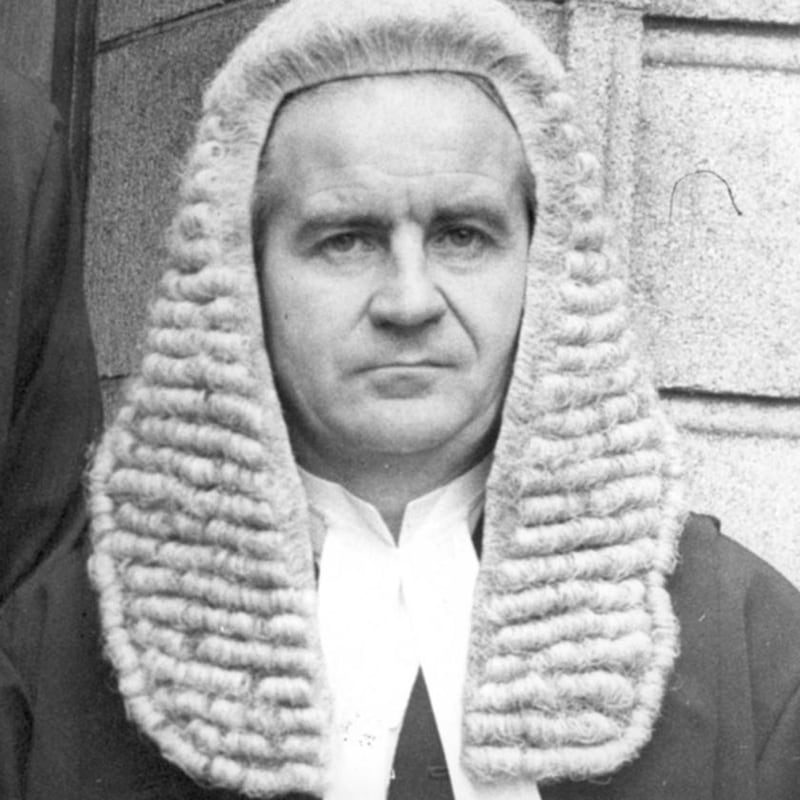
Malcolm MacArthur was now in custody. He directed gardaí to the shotgun hidden in the attic. When Hickey and other detectives checked it, they confirmed it was Dónal Dunne’s Miroku.
Macarthur was brought to Dún Laoghaire Garda station. The following morning he agreed to make a confession. It ran to 21 pages. He affirmed he was responsible for the deaths of Bridie Gargan and Dónal Dunne.
“The reason why I bought this all goes back to money. For the past two years my finances have been diminishing. This was something that I could not cope with. I wanted this hammer to injure somebody, to get a car, to travel down the country to get a gun because I had no transport. In turn, I had planned ahead to stick somebody up, and the object was to get money. I had been reading in the newspapers about all the robberies, and this seemed a way out of my obsessive financial situation. Part of the plan also involved a shovel because my attitude was that I wanted this venture to succeed, and if by chance I did kill anybody in the venture I would use the shovel to dispose of the body.”
However irrational and deluded he had been, there had been a clear motive. He wanted to get money and was prepared to kill to do so.
The attorney general had kept a diary all his life. In it he described that day as the most shattering of his life. But it was only the start of what turned out to be a nightmarish week for him. Connolly had the dreadful task of contacting Brenda Little in Tenerife to tell her of the extraordinary developments. She did not believe what he was saying at first. It was a very distressing call. Connolly later reflected on the impact it all had on him in a 1992 interview with me.
“It is very difficult to exaggerate exactly how dumbfounded I was. When I was later informed that he was wanted for murder I was even more astounded. Even though I rather pooh-poohed it at the time I was actually in a state of shock for the next few days, with the sense of all this being unreal. Up until then he was a person whom I would have held in the highest regard, and would have considered to be very reliable and trustworthy.”
Connolly had one more phone call to make that night. It was to Charles J Haughey. There was a telephone on Inishvickillane, the taoiseach’s private island off Co Kerry; Connolly rang the number at 10pm. He had great difficulty getting through, and when he did the line was very bad. Connolly told Haughey about Macarthur being arrested in his flat.
It was clear that Haughey had not grasped the import of the call. He asked had he himself met Macarthur at any stage and did not demur when Connolly told him he was going on holidays to the United States the next morning. Recalling the conversation 10 years later, Connolly told me Haughey had given him “full political clearance to proceed” with his vacation.
There followed a series of frantic phone calls from the taoiseach’s department to remote Inishvickillane over the following 24 hours. On Saturday morning the newspapers reported in a straightforward way that a man had been arrested for both murders, adding obliquely that the arrest had been made in the complex where the attorney general lived.
By this stage the media knew exactly where the arrest had occurred, and the Garda and the government were swamped with inquiries. There was no way to prevent the reporting of the sensational fact that a man sought for two brutal murders was arrested in the home of the attorney general.
In the early afternoon Macarthur was bundled into Dún Laoghaire courthouse, a modest Victorian-era building on a narrow lane. A huge scrum of media and onlookers had assembled outside. Some onlookers shouted abuse at the arrested man as he was taken through the doorway. Gardaí had thrown a blanket over his head in anticipation of identification issues in the trial.
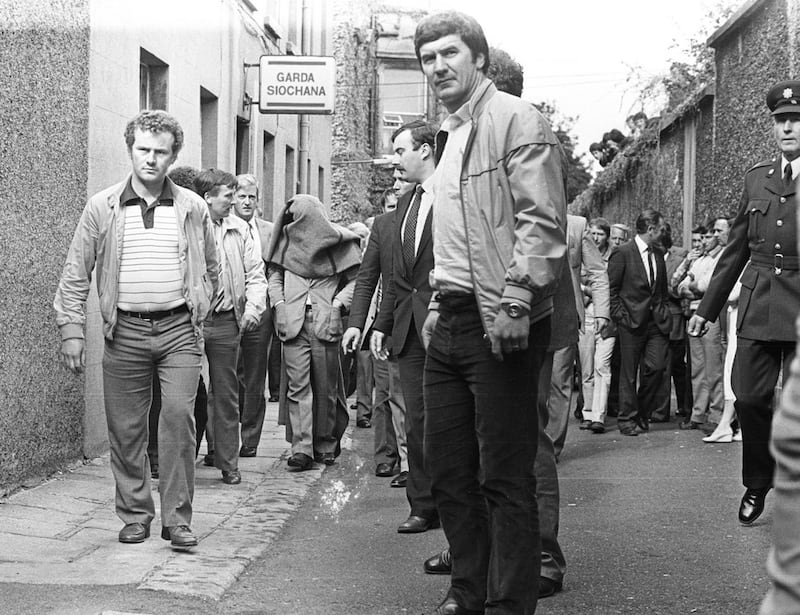
That Saturday morning Connolly was preparing to fly to London on the first leg of his journey to the US. He was visited by Courtney and Insp Noel Conroy. He refused to give a statement and insisted on going on his holidays despite what had happened the previous night. There were sharp exchanges, but the two gardaí eventually backed down. It was a poor decision by Connolly.
Government officials had by now got through to Haughey on the island and informed him of the gravity of the situation. The taoiseach managed to contact Connolly in London, on the first leg of his journey. Connolly refused to return and said they would talk again when he arrived in New York. He stayed that night in London and flew by Concorde to New York the following day.
The Sunday newspapers latched on to the story, and it was also being picked up by media abroad. It was now being reported that Macarthur had been arrested in Connolly’s flat. “A-G flies out as murder suspect charged” was the headline in the Sunday Tribune.
Haughey knew, as Joe Joyce and Peter Murtagh described it in The Boss, that all hell was about to break loose. He knew he had to get his attorney general back to Ireland immediately. It all blew up when Connolly arrived at John F Kennedy International Airport, in New York. He was besieged by reporters. The headline on the New York Post ran: “Irish biggie flees here after slay scandal.” The New York Daily News was slightly less declamatory: “Irish lawman in shocker.”
Connolly’s stay in New York was to last one evening. His government colleagues booked a return flight on Concorde the next day. Meanwhile, in Dublin, the Government Information Service was being overrun. Frank Dunlop, the government press secretary, said that as soon as the phone was put down after one call from a reporter, it would immediately ring again.
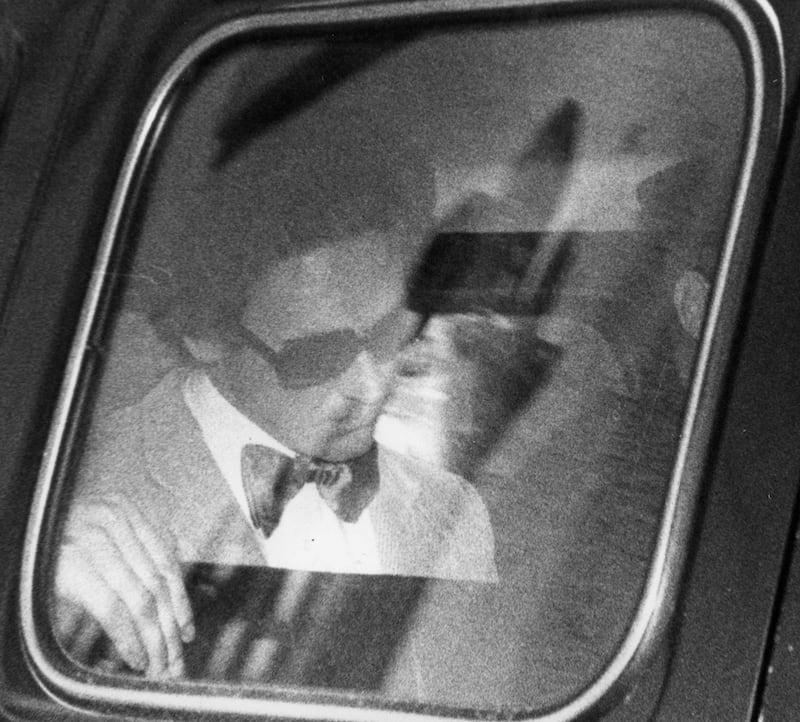
Haughey returned to Dublin on Sunday to deal with the crisis. The following morning Connolly began the trek back to Ireland, flying Concorde from New York to London and then on to Ireland that evening in an Air Corps aircraft. On the plane home he began drafting a statement about Macarthur. He did not know it at the time, but it would be the first draft of his statement of resignation. The language was formal and precise, but there was no missing its emotion and sentiment.
“I have known the accused socially for some years. I have been acquainted with his fiancee and members of her family for many years. So far as I am aware from conversations, the accused holds a postgraduate degree in Science from Cambridge University and a degree in Economics from the University of Southern California. Since last May he has been resident in Tenerife with his fiancée and their child. I understand that it had been his intention to reside there for a few months.
“On the evening of August 4th he arrived at my flat. He intimated to me that he had been in London and Belgium dealing with financial matters and that he would be some days in Ireland dealing with his financial affairs. I told him he could stay in my flat if he wished and he accepted.
“At no time did I have any knowledge whatsoever of the fact that the gardaí were trying to find him in relation to the offences with which he now stands charged. At no time did I have any occasion to entertain any such suspicion. The events which may have taken place have taken me wholly by surprise and come as a very great personal shock to me.”
He arrived at Baldonnel airfield, outside Dublin exhausted, having spent three days criss-crossing the Atlantic. He had been followed by a posse of reporters and cameras, and his return to Dublin was broadcast live internationally. He was taken immediately from there to Abbeville, Haughey’s mansion in Kinsealy, just north of Dublin. As the car drove through the gate a media mob awaited. Dunlop was present for the conversation between Haughey and Connolly. He said it was difficult, with Connolly insisting he had done nothing wrong and was an innocent party. But the result was inevitable. By the time he left Kinsealy he was no longer attorney general.
His statement concluded: “Although my involvement in this case is entirely innocent, I have to have responsible regard to the unique situation and duties attached under the Constitution and the law to the office of the attorney general. I must also have regard to the embarrassment which, however unwittingly, must inevitably be caused to the government by these events.
“Accordingly I have come to the conclusion with grave regret that it is my public duty to tender my resignation from that office. I have therefore tendered my resignation to the taoiseach which he has this day accepted.”
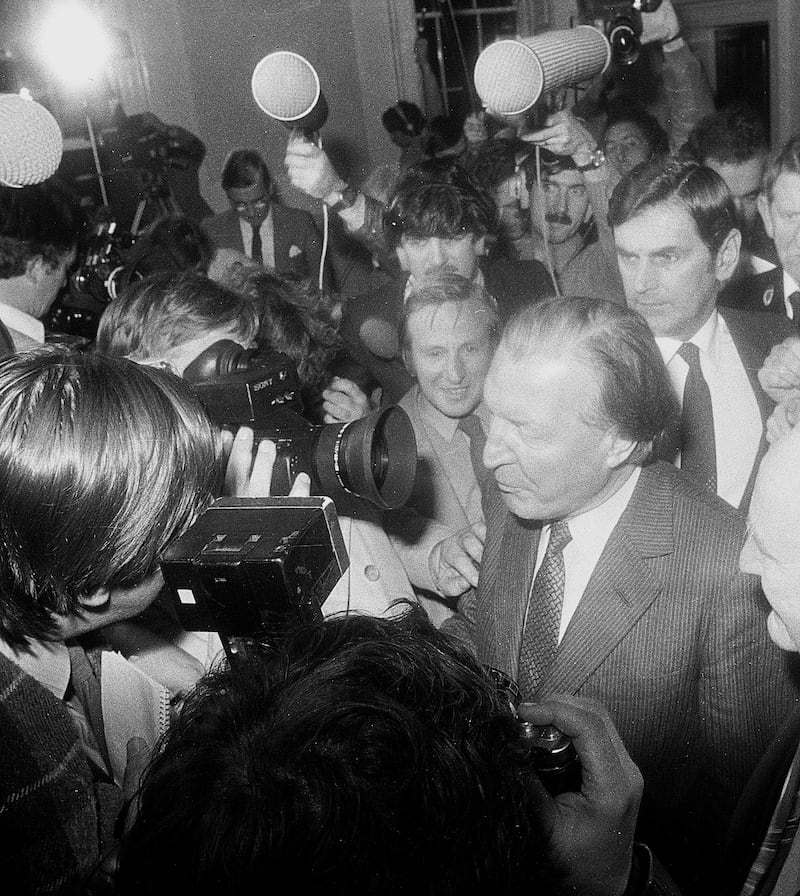
That did not draw a line under the matter politically. The converse, in fact. The government had released little information over the weekend. And the information that had been released had seemed confusing and contradictory. Already theories about cover-ups and conspiracies were abounding. There were also rumours about the relationship between Connolly and Macarthur, none of which was true. It was known that in the 1970s both had socialised in bars such as the Bailey and Bartley Dunne, both of which had a gay clientele. But neither man was gay.
The Government Information Service decided the best way to clear up all the supposition and allegations of “uisce faoi thalamh” was to have Haughey host a press conference. That he did on Tuesday evening. Haughey described the events and coincidences as a “grotesque mischance”. He kept on returning to the words “grotesque”, “unbelievable”, “bizarre” and “unprecedented” as he tried to describe all that happened. They were later shortened to the infamous acronym Gubu by one of Haughey’s greatest political enemies, Conor Cruise O’Brien. Gubu became a shorthand after that for every political controversy or cock-up involving Haughey.
During a long career Haughey had encountered some spectacular failures and defenestrations. He was often the author of his own misfortune. Not this time. The paradox was that Gubu came to define him. As Frank Dunlop recalls, “The incident is so emblematic of what was happening when Charlie was taoiseach at that period that it didn’t matter what happened. If the cat was killed. It was Charlie’s fault. As John Healy said famously, ‘If Charlie had ducks, they’d drown.’”
The evidence against Macarthur was overwhelming, and it was clear he was going to be convicted. A deal was reached that if Macarthur pleaded guilty to Bridie Gargan’s murder, a nolle prosequi would be entered for Dónal Dunne’s
Peter Murtagh describes this short-lived government as one of the most ramshackle in Irish political history. It limped on for another month or so before collapsing early in the autumn. Gubu certainly had contributed to its demise. Haughey’s biographer Prof Gary Murphy says that “Gubu, in many ways, haunted Haughey like Banquo’s ghost. He couldn’t shake it off.”
While the gay rumours had no foundations, that did not prevent them from spreading. The situation was not helped by the unusual figure cut by Macarthur, who started appearing in court wearing dickie bows. Beyond that there were fanciful theories that there was some kind of elaborate cover-up, or that the whole affair was a black-flag operation by the British secret services.
This is Murtagh’s recollection: “Even then, rumours were flying around, because of the context of the time, which I’ve spoken of already. People made assumptions. They made assumptions that this was a stitch-up.”
The lack of transparency surrounding the process added fuel to the fire. Macarthur’s legal team was led by Paddy McEntee, one of the most celebrated defence lawyers in Ireland. They explored but rejected the idea of a plea of insanity. According to an investigation by Magill magazine the following year, psychiatrists who had reviewed Macarthur in Mountjoy Prison did not support a diagnosis of insanity. In addition, such a plea would require an understanding jury, and it was felt that Macarthur would not elicit much sympathy.
The lawyers then worked towards getting a plea bargain. The evidence against Macarthur was overwhelming, and it was clear he was going to be convicted of murder. A deal was reached that if Macarthur pleaded guilty to Bridie Gargan’s murder, a nolle prosequi (or a nulled prosecution) would be entered for Dónal Dunne’s murder.
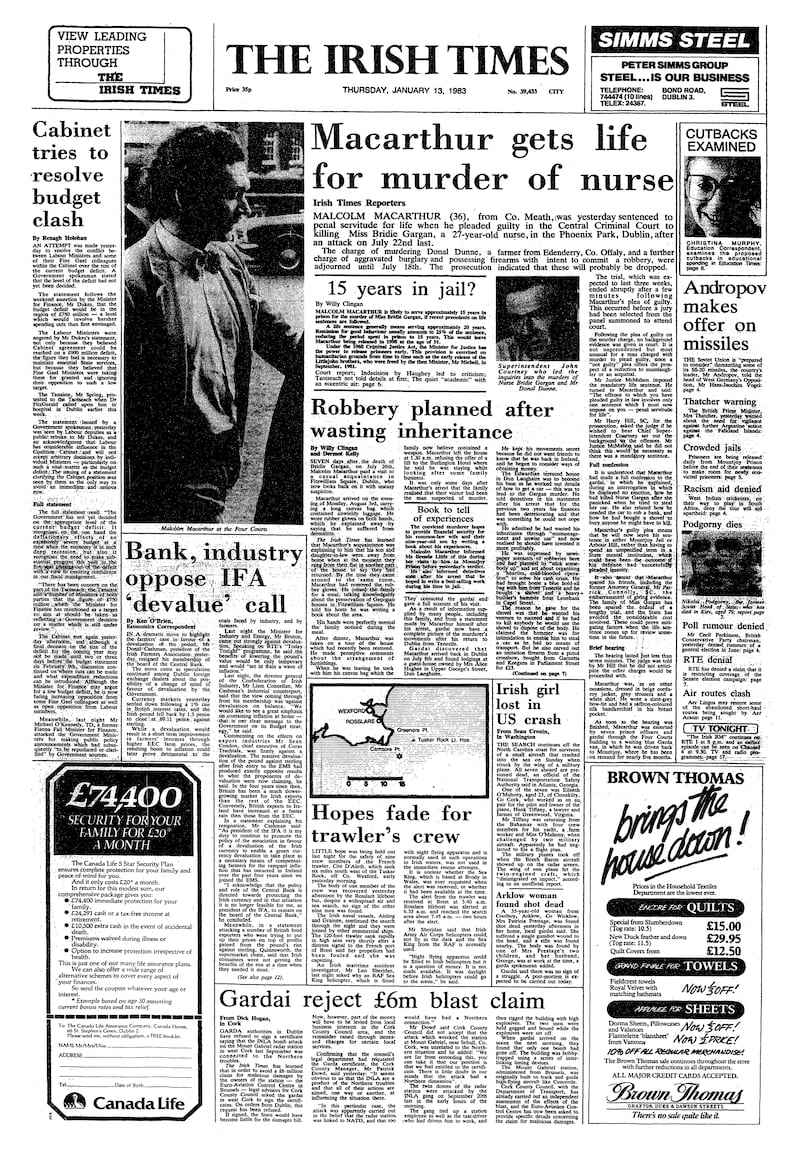
This outraged the family of Dónal Dunne. His brother Christy campaigned for years to have the case reopened, with no success. When the case came to trial it shockingly lasted only five minutes. After Macarthur had pleaded guilty to Gargan’s murder, Courtney was prepared to read a short statement of the facts. If he had been allowed to do so it would have given some comfort to the families of the victims. But the presiding judge, James McMahon, would not allow it to be read. It added to the public outrage and galvanised the views of those who believe something more sinister was afoot, and that there was a cover-up.
Shortly after his conviction, David Hanly interviewed Macarthur’s mother, Irene, for RTÉ. She was very candid about her distant relationship with her only child. She also told Hanly that she believed in a “life for a life” when somebody was murdered.
Their relationship was a complex one. Like Brenda Little, she visited him frequently in prison. Publicly, Macarthur had expressed no remorse. Indeed, he never spoke about what happened again, to his mother or to others. He referred to it as the “case” or the “event”. While detectives were examining Macarthur’s possessions in Connolly’s flat they came across a handwritten sheet hidden inside a book. It contained detailed notes about how to kill a person by electrocution and pass it off as an accident caused by faulty wiring. These notes suggest Macarthur had planned to kill his own mother at one stage.
The plan was to kill her while making it look as if it was caused by an “electric fire with faulty plug attached”. It stated: “None of my fingerprints — make sure hers on handle.” He advised himself to “wear gloves always — no prints”. It continued: “Wait for a while to ensure that death is final. During this time take a few very important items (certain small photos) into my possession. Make an inventory of their important items too so that I can check on their presence when I arrive for the funeral.”
The note’s discovery put paid to any remote hope Macarthur had of a relatively early release. He was transferred to Arbour Hill Prison, in Stoneybatter in Dublin, which then housed most of the State’s sex offenders; he looked after its printing press for many years. Towards the end of his time in jail he was in the open Shelton Abbey Prison, in Co Wicklow.
Successive ministers for justice refused him parole. They considered him a threat to his mother while she was still alive. She died in 2008, in Mullingar, Co Westmeath and she is buried in the family plot in Trim.
The investigators
Many of the team of 50 detectives involved in the Malcolm Macarthur case went on to have distinguished careers in the Garda Síochána. Tony Hickey and John O’Mahony became assistant commissioners. Det Insp Noel Conroy (then based in Cabra) was Garda commissioner between 2003 and 2007.
In the course of the investigation Conroy interviewed the American diplomat Harry Bieling along with Tony Hickey and was involved in the operation around Pilot View that led to Macarthur’s capture. Det Sgt Denis Donegan was the person who tracked down Macarthur’s old flat in Donnybrook and discovered it belonged to Attorney General Patrick Connolly, so confirming the likelihood Macarthur was hiding in Pilot View.
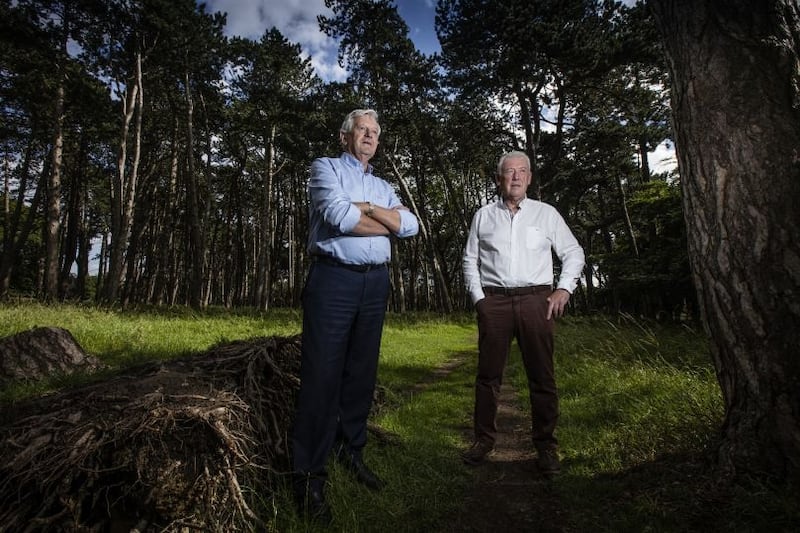
The head of the murder squad, Det Chief Supt Dan Murphy, and Det Supt John Courtney led the investigation along with Det Supt Jim Brogan (father of the Dublin footballer Bernard Brogan, and grandfather of two other Dublin football stars, Bernard jnr and Alan); Det Supt John Reynolds (father of RTÉ News’s crime correspondent, Paul Reynolds).
Other prominent members of the team included Det Sgt Pat Lynagh, Det Sgt Tony Sourke, Det Sgt Brendan Kennedy and Det Sgt Joe Shelley.
Det Garda Cahal Murphy of the Kevin Street station played an important role when he ensured a blood sample was taken from the critically injured Bridie Gargan soon after her admission to hospital.
Frank Hand, a detective, was John O’Mahony’s partner during this investigation. Two years later, on August 10th, 1984, he and Det Garda Michael Dowd were escorting a cash delivery to a post office in Co Meath when a Provisional IRA unit opened fire on them. Det Hand was struck and subsequently died of his wounds. He was 26.
In the event Macarthur became one of the longest-serving lifers in Ireland, being released in 2014, more than 30 years after his incarceration. The notoriety of the case never really faded from the public consciousness. Since then he has lived a quiet life in Dublin, spending much of his time reading and studying. He declined to be interviewed for this article.
Macarthur believed that he was superior and, in a sign of a dissociated mindset, that he could undo his acts by simply wishing them away. The killings were appalling, but he never publicly expressed regret for them—perhaps there was never a circumstance in which he could do so. For the gardaí who investigated, these were clear-cut murders, because there was a clear motive behind the awful acts: the need to get money.
Questions remain about who Macarthur was and why he did what he did. He has been described as a Walter Mitty-type fantasist, an incompetent criminal yet a heartless murderer. Was there also a deep underlying psychological flaw? A few years after the case John Banville wrote a compelling novel, The Book of Evidence, which told a remarkably similar tale to that of Macarthur. Its antihero was Freddie Montgomery, whose surname was that of a famous British general. This was an indirect reference to Macarthur, who shares a surname with a famous American general.
In a telling passage Montgomery explains why he showed no remorse for killing a young servant girl. “Remorse implies the expectation of forgiveness and I knew that what I had done was unforgivable. I could have feigned regret and sorrow, guilt, all that, but to what end? Even if I had felt such things, truly, in the deepest depths of my heart, would it have altered anything? The deed was done and would not be cancelled by cries of anguish and repentance.”
Gubu came to define that sweltering summer of 1982 in Ireland, the terrible murders and the sensational consequences that almost brought down a government.


































